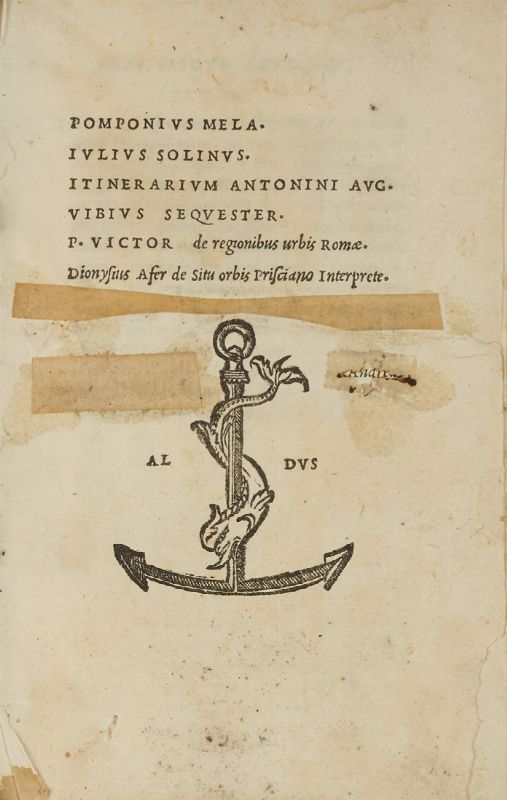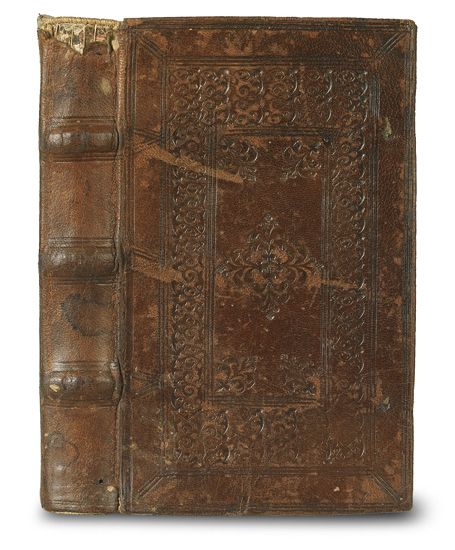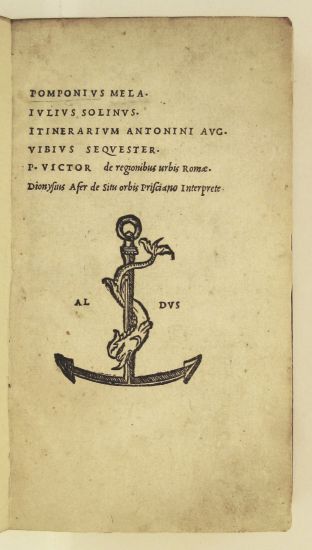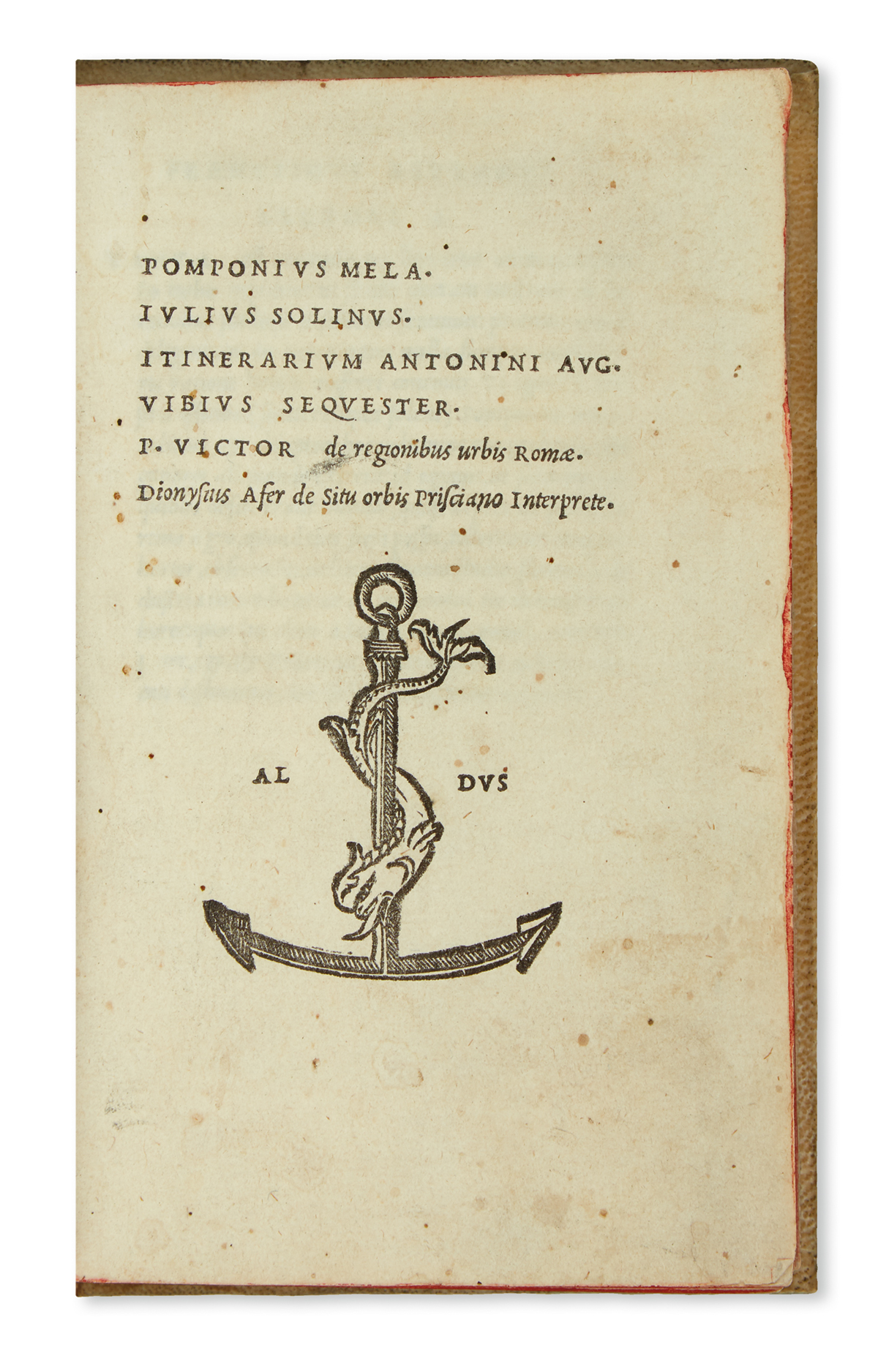Mela, Pomponius, Dionysius Periegetes, and Priscian (translator)Cosmographia. [With:] De situ orbis. Venice: Erhard Ratdolt July 18, 1482
2 vols. in one, 4to (191 x 146 mm). A-F8; 48 ff; 30 lines per page. Cosmographia: 1-29 ff. De situ orbis: 30-48 ff. Full-page woodcut map of the world on a Ptolemaic cone-shaped projection with architectural border and letterpress text, woodcut and floriated initials, rubricated throughout, gothic letter Latin text; border of the woodcut map shaved, conjugate leaves a1.8 have been extended. Bound in green full morocco by Zaehnsdorf, paneled in gilt, spine with raised bands in six compartments, all of which gilt-paneled, second and third gilt-lettered, marbled endpapers, edges sprinkled red. Rare. The 1482 Ratdolt edition of Mela's incunable Cosmographia, the first edition of the first Latin work dedicated to geography to include a map of the world.
"Mela’s concept of the world as published here, ten years before the discovery of the New World, was the most widely accepted cosmography in Europe" (Streeter). The present title is so foundational to our understanding of the modern world that two of the most important book collectors, E. D. Church and Thomas W. Streeter, each listed it first in their collection catalogs. The map in this edition of Cosmographia by Mela, the earliest known Roman geographer, was the first map to incorporate knowledge from the Portuguese explorations of the West Coast of Africa. This map modified the Ptolemaic rendering, revealing a true Western Africa based on reports of Portugal's success further south, making it current with then-known geographical knowledge. No earlier printed map recognized this important step toward the rounding of the Cape of Good Hope, achieved by Bartolomeu Dias just six years post publication. The title of the map "Novellae etati ad geographie vmiculatos calles huma no viro necessarios flores aspirati votu bnmereti ponit" translates as: "If, in a new lease of life, a man seeks to attain the wormlike paths of geography, he is bound to find the flowers that belong there, for he deserves them." The map is rarely present, as Nordenskiöld relates: "The map is generally wanting, but that it really belongs to the work is shown by the watermark corresponding to the watermarks of the text." Published in the same year as Lienhart Holl's Cosmographia, Mela's world map includes additions to the Ptolemaic model. One of the more obvious changes is the addition of Scandinavia, and for the first time, the Orkney Islands off the Northeast coast of Scotland. Mela's map was cited with other early texts, including those by Macrobius, Ptolemy, Pliny, and Aristotle, as part of the reading background of Christopher Columbus, who would sail to the New World just a decade later: "In its consideration of the oceans, this work would not have been particularly useful to Columbus, but in his view of the earth, Mela raised the probability that the Southern Hemisphere was inhabited, a novel idea for Christian believers in the biblical version of the Creation" (James Ford Bell Library). REFERENCE:BMC V 286; Bod-inc M-179; BSB-Ink P-687; Brown 41; Campbell 119; Church 1; Essling 274; Goff M-452; GW M34876; Klebs 675.6; Nordenskiöld 36; Oates 1751; Polain 2661; Proctor 4385; Shirley 8; Stillwell 389; Streeter Sale 1; Walsh 1809; Wilson 115
Mela, Pomponius, Dionysius Periegetes, and Priscian (translator)Cosmographia. [With:] De situ orbis. Venice: Erhard Ratdolt July 18, 1482
2 vols. in one, 4to (191 x 146 mm). A-F8; 48 ff; 30 lines per page. Cosmographia: 1-29 ff. De situ orbis: 30-48 ff. Full-page woodcut map of the world on a Ptolemaic cone-shaped projection with architectural border and letterpress text, woodcut and floriated initials, rubricated throughout, gothic letter Latin text; border of the woodcut map shaved, conjugate leaves a1.8 have been extended. Bound in green full morocco by Zaehnsdorf, paneled in gilt, spine with raised bands in six compartments, all of which gilt-paneled, second and third gilt-lettered, marbled endpapers, edges sprinkled red. Rare. The 1482 Ratdolt edition of Mela's incunable Cosmographia, the first edition of the first Latin work dedicated to geography to include a map of the world.
"Mela’s concept of the world as published here, ten years before the discovery of the New World, was the most widely accepted cosmography in Europe" (Streeter). The present title is so foundational to our understanding of the modern world that two of the most important book collectors, E. D. Church and Thomas W. Streeter, each listed it first in their collection catalogs. The map in this edition of Cosmographia by Mela, the earliest known Roman geographer, was the first map to incorporate knowledge from the Portuguese explorations of the West Coast of Africa. This map modified the Ptolemaic rendering, revealing a true Western Africa based on reports of Portugal's success further south, making it current with then-known geographical knowledge. No earlier printed map recognized this important step toward the rounding of the Cape of Good Hope, achieved by Bartolomeu Dias just six years post publication. The title of the map "Novellae etati ad geographie vmiculatos calles huma no viro necessarios flores aspirati votu bnmereti ponit" translates as: "If, in a new lease of life, a man seeks to attain the wormlike paths of geography, he is bound to find the flowers that belong there, for he deserves them." The map is rarely present, as Nordenskiöld relates: "The map is generally wanting, but that it really belongs to the work is shown by the watermark corresponding to the watermarks of the text." Published in the same year as Lienhart Holl's Cosmographia, Mela's world map includes additions to the Ptolemaic model. One of the more obvious changes is the addition of Scandinavia, and for the first time, the Orkney Islands off the Northeast coast of Scotland. Mela's map was cited with other early texts, including those by Macrobius, Ptolemy, Pliny, and Aristotle, as part of the reading background of Christopher Columbus, who would sail to the New World just a decade later: "In its consideration of the oceans, this work would not have been particularly useful to Columbus, but in his view of the earth, Mela raised the probability that the Southern Hemisphere was inhabited, a novel idea for Christian believers in the biblical version of the Creation" (James Ford Bell Library). REFERENCE:BMC V 286; Bod-inc M-179; BSB-Ink P-687; Brown 41; Campbell 119; Church 1; Essling 274; Goff M-452; GW M34876; Klebs 675.6; Nordenskiöld 36; Oates 1751; Polain 2661; Proctor 4385; Shirley 8; Stillwell 389; Streeter Sale 1; Walsh 1809; Wilson 115











Testen Sie LotSearch und seine Premium-Features 7 Tage - ohne Kosten!
Lassen Sie sich automatisch über neue Objekte in kommenden Auktionen benachrichtigen.
Suchauftrag anlegen